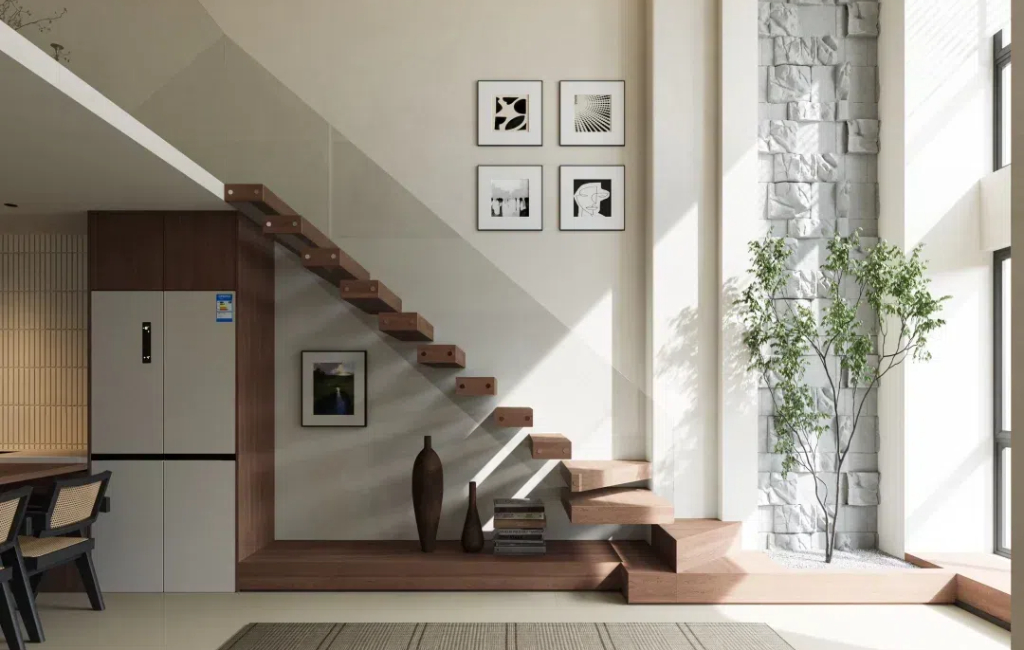Elevating Style and Space: The Art of Incorporating Floating Staircase
Floating stairs, are a modern architectural feature that has gained popularity for their sleek and minimalist design. Unlike traditional staircases, floating stairs appear to "float" without visible support, giving them a light and airy appearance. In today’s world, where space is often at a premium, finding ways to maximize every square foot is essential. This article explores how floating stairs not only add a contemporary touch to interiors but also serve as an effective solution for saving space in both residential and commercial settings.
What Are Floating Stairs?
Floating stairs are a type of staircase that is characterized by the absence of visible risers or support structures, creating the illusion that the treads are "floating" in mid-air. These stairs are typically anchored to a wall on one side, with each tread extending outward without visible means of support underneath. Compared to traditional staircases, which often have bulky supports and risers, floating stairs offer a minimalist aesthetic. Common materials used for floating stairs include wood, metal, and glass, each contributing to a unique look that can be customized to suit various design preferences.
Space-Saving Benefits of Floating Stairs
Eliminating Support Structures
Traditional staircases frequently necessitate the presence of support columns or walls, which not only serve a structural purpose but also significantly contribute to the overall footprint of the staircase. These support structures often occupy valuable floor space, limiting the potential for other functional or aesthetic elements within the area. In contrast, floating stairs elegantly bypass this constraint by relying solely on their stringers and, in some cases, a single wall for support. This innovative design approach frees up substantial amounts of floor space, allowing homeowners and designers to utilize this area for additional purposes, such as installing furniture, creating open floor plans, or incorporating decorative elements that enhance the overall ambiance of the space.
Maximizing Vertical Space:
In multi-level homes or lofts where space is at a premium, every inch counts. Floating stairs represent a smart solution to maximizing the efficient use of vertical space. By eliminating the need for bulky support structures beneath the stairs, floating stairs create a clear path from one level to another, without encroaching on the horizontal space below. This design feature is particularly advantageous in compact living environments, where every square foot is crucial. Moreover, the sleek profile of floating stairs allows for better circulation and more natural light to penetrate through the staircase, further enhancing the sense of spaciousness and openness.

Visual Openness:
The open design of floating stairs is a key factor in creating a sense of spaciousness that transcends the actual dimensions of the space. By minimizing visual obstructions and allowing light and air to flow freely beneath the stairs, floating stairs effectively break down the boundaries of the staircase, making it feel like a seamless extension of the surrounding area. This effect is particularly pronounced in small or cramped spaces, where the openness of the floating stairs can significantly alter the perceived size and atmosphere of the room. The result is a more inviting, airy, and visually expansive environment that feels larger than it actually is.
Customizable Designs:
One of the greatest advantages of floating stairs lies in their versatility and customizability. These staircases can be tailored to fit into even the tightest of spaces or designed to seamlessly integrate with existing architectural features, such as windows, doors, or furniture. This level of customization ensures that floating stairs can be incorporated into virtually any interior design scheme, maximizing the potential of every inch of space. Whether it's a narrow hallway, a corner of a room, or a grand entranceway, floating stairs can be crafted to fit the specific dimensions and aesthetic requirements of the space, ensuring that every aspect of the design contributes to the overall harmony and functionality of the environment.

Conclusion
While floating stairs are undeniably stylish and space-saving, there are important practical considerations to keep in mind. Safety is a top priority, and features such as railings, non-slip treads, and secure anchoring systems are essential to ensure that the stairs are both functional and safe. The structural support and installation of floating stairs require careful planning and professional expertise, as the design needs to balance aesthetics with stability. Cost is another factor to consider; while floating stairs can be more expensive than traditional staircases due to their custom design and installation, the long-term value they add to a property often justifies the investment.
In conclusion, floating stairs are not only a stylish design choice but also a practical solution for saving space in today’s compact living environments. Their open design, compact footprint, and versatile aesthetic make them ideal for both residential and commercial applications. By choosing floating stairs, homeowners and designers can maximize space without compromising on style or functionality, making them an excellent investment for modern living.
